
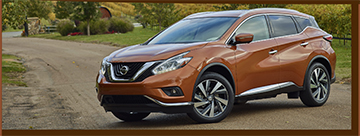
The RE0F10J Xtronic CVT®
The RE0F10J Xtronic CVT for the 2015 Murano® has been modified slightly with improvements to the previous Murano’s CVT. The new CVT’s design results in approximately 6-7% improvement in fuel economy. This is achieved because the new CVT has reduced friction due to reduced pulley pressure, a smaller oil pump, and the use of NS-3 Low Viscosity Oil. Controls have been added for improvement of the transmission efficiency for early torque converter lock-up, which helps to provide slip control of the torque converter clutch. This along with revised highway gear ratios allows the engine to run at lower highway RPMs, which provides better fuel economy and less engine noise.
D-Step Transmission Tuning
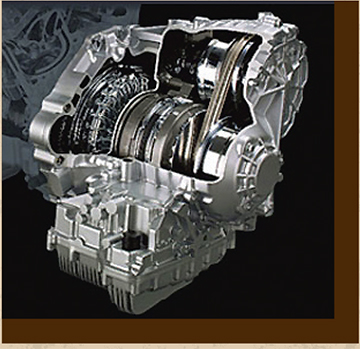
The RE0F10J includes transmission tuning commonly referred to as D-Step. D-Step Shift Logic is a software update that will give drivers the feeling that their vehicle is shifting gears like a conventional automatic transmission. Once the vehicle reaches 4,000 RPMs, the new software commands the system to create a subtle drop in driving force and a slight jump ahead essentially forcing the transmission to “hold a ratio and then shift.” This tuning simulates shifts during rapid acceleration, providing stepped acceleration with a linear acceleration feel without necessarily holding a high constant engine RPM. During mild acceleration, the transmission operates as a normal CVT. At cruising speed, D-Step allows the transmission to immediately change ratios, providing quick acceleration in situations such as passing another vehicle. During aggressive acceleration, it allows engine speed to build as the vehicle speed increases, which also reduces the engine noise that comes from constant high rev acceleration.
D-Step helps select the gear ratio that can give driving force to meet the driver’s intent or vehicle situation and driving condition. When a driving condition such as vehicle speed or accelerator pedal position is detected, it determines the most appropriate gear ratio and shifting method before reaching the intended speed. The information is outputted to the primary pressure solenoid valve and secondary pressure solenoid valve to control the line pressure that determines the pulley (movable pulley) position and to control the gear position.
Shift Control System Diagram
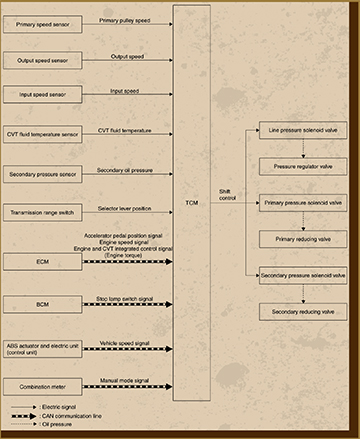
The TCM judges the vehicle driving status based on the signals from the sensors, switches, and other control units to perform optimal transaxle control. The TCM performs accurate control by retrieving data (inherent characteristic value) from each solenoid. For this reason, it is necessary to save data from the current TCM in CONSULT before replacing a TCM.
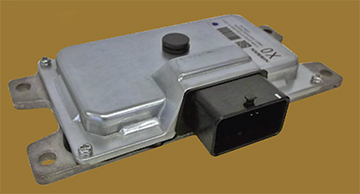
The 2015 Murano comes standard with front-wheel drive (FWD) or can be equipped with an Intuitive All-Wheel Drive (AWD) option. AWD vehicles are equipped with an R145 rear differential unit without a torsional damper. AWD Muranos use a full-time system rather than a selectable system with a 4x4 selector dial like the Pathfinder.
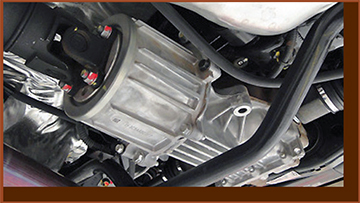
The Intuitive AWD optimizes power distribution for improved traction under various road conditions as the terrain varies. Under normal road conditions, the system operates in front-wheel drive for improved fuel efficiency. AWD automatically directs up to 50% of the available power to the rear axle for reduced-slip start-ups. The Intuitive AWD system works in conjunction with the Vehicle Dynamic Control (VDC) system to adjust the torque split between the front and rear wheels to help the driver maintain control during cornering for improved grip. If the vehicle begins to slide through a curve, Intuitive AWD directs engine power to the appropriate wheel(s) to help the driver maintain control of the vehicle. Once the vehicle is out of the curve and up to speed on a straighter road, the system efficiently sends all the power back to the front wheels.
AWD System Diagram
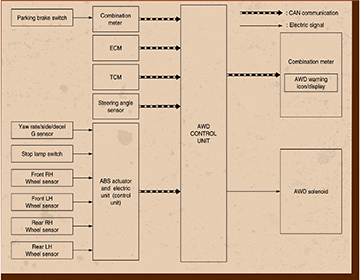
Electronic control allows optimal distribution of torque to front/rear wheels to match road conditions.
Electric Controlled Coupling
The electric controlled coupling is integrated with the rear final drive to help transmit driving force. The electric controlled coupling's functions are:
1. The AWD control unit supplies command current to the electric controlled coupling (AWD solenoid).
2. The control clutch is engaged by an electromagnet and torque is detected in the control clutch.
3. The cam operates in response to the control clutch torque and applies pressure to the main clutch.
4. The main clutch transmits torque to the front wheels according to available engine power.
5. Transmission torque to the rear wheels is determined according to command current.
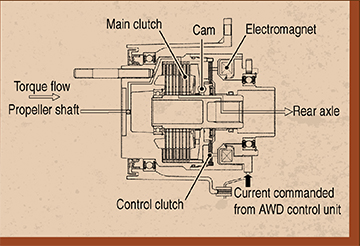
Protection Function
The AWD system activates its protection function (shuts down the AWD system temporarily) if the AWD system detects a high load continuously or an internal temperature rise of the electronic controlled coupling. This is not a malfunction. The AWD system function is automatically restored if the AWD system no longer detects an AWD high temperature or any overload.
The AWD system can also activate a protection mode that shuts down its function temporarily if it detects a difference of the front wheel tire size from the rear tire size. In this case, the AWD system function is automatically restored when the tire size difference is eliminated.